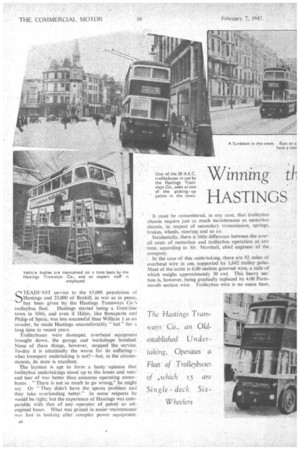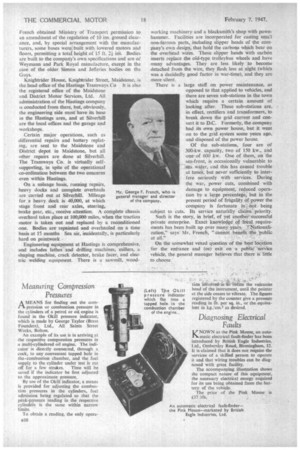Winning tt Battle
Page 42

Page 43

Page 44

If you've noticed an error in this article please click here to report it so we can fix it.
HASTINGS 7RANSPORT
By J. D. McLintock STEADFAST service to the 65,000 population of Hastings and 23,000 of Bexhill, in war as in peace, has been given by the Hastings Tramways Co.'s
trolleybus fleet. Hastings started being a front-line town in 1066, and even if Hitler, like Bonaparte and Philip of Spain, was less successful than William 1 as an invader, he made Hastings uncomfortably " hot " for a long time in recent years. .
Trolleybuses were damaged, overhead equipment brought down, the garage and workshops bombed. None of these things, however, stopped the service. To-day it is admittedly the worse for its suffering— what transport undertaking is not?—but, in the circumstances, its state is excellent.
The layman is apt to form a hasty opinion that trolleybus undertakings stood up to the losses and wear and tear of war better than concerns operating motorbuses. buses. " There is not so much to go wrong," he might say Or "They didn't have the spares problem and they take overloading better." In some respects he would be right; but the experience of Hastings was comparable with. that of any operator of petrol or oilengined buses. What was gained in easier maintenance was lost in looking after complex power equipment.
It must be remembered, in any case, that trolleybus chassis require just as much maintenance as motorbus chassis, in respect of secondary transmission, springs. brakes, wheels, steering and so on.
Incidentally, there is little difference between the overall costs of -motorbus and trolleybus operation at any time, according to Mr. Marshall, chief engineer of the . company.
In the case of this undertaking, there are 92 miles of overhead wire in use, supported by 1,642 trolley poles. Most of the cable is 6.00 section grooved wire, a mile of which weighs approximately 30 cwt. This heavy section is, however, being gradually replaced by 4.00 Portsmouth .section wire. Trolleybus wire is no mean item.
as one realizes on .handling a short piece of it. Nearly as thick as a little finger, it is tough, heavy and unbending.
The Hastings Tramways Co., as its name suggests, was built up from a tramways business in the town, operated from 1905 to 1929. The first service, opened on July 31, 1905, was o'er a circle including Ore. Silverhill and Hollington. Subsequent extensions gav&transport to the Old Town, Bexhill, London Road (St. Leonards), Cooden, and the sea-front. The last tram was run on March 13„ 1929, and under its Acts of 1927, and 1930 the company converted to the trolleybus system. The first trolleybus route was from Hollington to Fishmarket via Bohemia Road, and was opened on April 1, 1928. The date chosen casts no reflection on the directors, as proved by subsequent records! Between 1928 and 1931.varions extensions were made, and in November, 1935, Maidstone and District Motor Services, Ltd., acquired control of the company. in [939, the route mileage was. 22.25, with 58 buses in operation, there being 8 double-deckers with 56-seater bodies and 50 single-deckers with 30-32-seater bodies, all on Guy 'chassis.. Then, as now, the director and general manager was Mr, George F. French, well known as a practical and theoretical engineer. A pioneer in the passenger transport industry, he wasted little time in getting to know all the answers about trolleybuses, in addition to Most other things on wheels. Secretary qf the company is Mr. Percy Graefe, F.C.I.S.,, M.Inst.T., who is Mr. French's right-hand man at Knightrider House, Maidstone.
.
01' the pre-wax fleet, but 15 Guy single-deekers are now running. The remainder consists of 20,A RC. double-deckers and 10 Sunbeam double-deckers, the total thus being only 45, but mainly of modern type:. Formerly there_ was a large proportion of single-deckers, because of the existence of certain tow bridges, hot Mr.
French obtained Ministry of Transport permission to an amendment of the regulation of 10 ins, ground clearance, and, by special arrangement with the manufacturers, some buses were built with lowered motors and floors, permitting a total; height of 15 ft. 21 his. Bodies are built to the company's own specifications and are of Weyrnann and Park Royal manufacture, except in the case of the older Simms and Jefferies bodies on the Guys.
Knightrider House, Knightrider Street, Maidstone, is the head office of the Hastings Tramways Co It is also the registered office of the Maidstone and District Motor Services, Ltd. All administration of the Hastings company is conducted from there, but, obviously, the engineering side must have its base in the Hastings area, and at Silverhill are the local offices and the garage and workshops.
Certain major operations, such as differential repairs and battery replating. are sent to the Maidstone and District depot in Maidstone, but all other repairs are done at Silverhill. The Tramways Co. is virtually selfsupporting, in spite of the operational co-ordination between the two concerns even within Hastings.
On a mileage basis, running repairs. heavy docks and complete overhauls are carried out at Silverhill. Mileage for a heavy dock is 40,000, at which stage front and rear axles, steering, brake gear, etc., receive attention. A complete chassis overhaul takes place at 100,000 miles, when the traction motor is taken out and replaced by a reconditioned one. Bodies are repainted and overhauled on a time basis at 15 months Sea air, incidentally, is particularly hard on paintwork Engineering equipment at Hastings is comprehensive, and includes lathes and drilling machines, millers, a shaping machine, crack detector, brake facer, and electric welding equipment. There is a sawmill, wood
working machinery and a blacksmith's shop with powei hammer. Facilities are incorporated for casting sma:1 non-ferrous parts, including slipper heads of the com pany's own design, that hold the carbons which bear on the overhead wires. These slipper heads with carbon inserts replace the old-type trolleybus wheels and have many advantages. They are less likely to become detached from the wire, they flash less at night (which was a decidedly good factor in war-time), and they are more silent.
There is a large staff on power maintenance, as opposed to that applied to vehicles, and there are seven sub-stations in the town which require a certain amount of looking after. These sub-stations are, in effect, rectifiers and transformers, to break down the grid current and convert it to D.C. Formerly, the company
had its own power house, but it went on to the grid system some years ago, and disposed of the power house.
Of the sub-stations, four are of 3004w. capacity, two of 150 kw., and one of 600 kw. One of them, on the sea-front, is occasionally vulnerable to Oa water, and this has caused trouble at times, but never sufficiently to inter fere seriously with services. During the war, power cuts, combined with damage to equipment, reduced opera
tion by a large percentage, but in the present period Of frugality of power the
company is fortunate in not being
subject to cuts. Its service naturally claims priority. Such is the story, in brief, of yet another successful private enterprise. &att knowledge of focal require ments has been built up over many. years. " Nationalization," says Mr. French, "cannot benefit the public at all."
On the somewhat vexed question of the best location for the entrance and (or.) exit on a • Nike 'iserVicer vehicle, the general manager believes that there is little to choose




















































































